The Smart Fabric Market is estimated to be valued at USD 5.0 billion in 2025 and is projected to reach USD 31.0 billion by 2035, registering a compound annual growth rate (CAGR) of 20.0% over the forecast period.
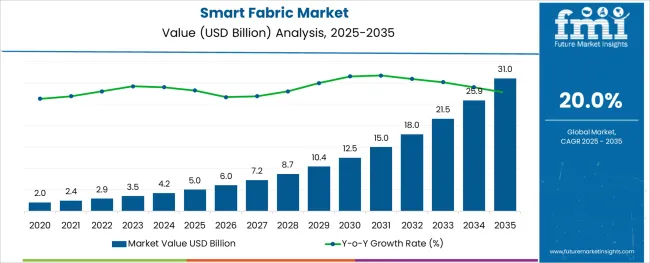
The smart fabric market is experiencing strong traction, supported by the convergence of textiles and electronics to enable responsive, functional clothing across sectors such as sports, healthcare, defense, and fashion. Advances in conductive yarns, embedded sensors, and energy-harvesting technologies are enabling fabrics to track biometric data, respond to environmental stimuli, and improve comfort or performance.
Regulatory interest in wearable medical devices and the growing demand for remote health monitoring have further accelerated innovation and commercialization. Manufacturers are leveraging data-driven design and collaborating with technology providers to enhance product capability and user experience.
Looking ahead, broader adoption is expected as 5G, AI, and IoT ecosystems expand, creating new use cases for connected garments and accessories. Distribution models are also evolving, with online platforms and DTC channels becoming key routes to market for both startups and established brands.
The market is segmented by Application, Function, and Distribution Channel and region. By Application, the market is divided into Performance Tracking, Energy Generation, Aesthetics, and Others. In terms of Function, the market is classified into Healthcare, Sports, Defense and Military, and Others.
Based on Distribution Channel, the market is segmented into Online Store, Direct, Indirect, Hypermarket/Supermarket, and Specialty Stores. Regionally, the market is classified into North America, Latin America, Western Europe, Eastern Europe, Balkan & Baltic Countries, Russia & Belarus, Central Asia, East Asia, South Asia & Pacific, and the Middle East & Africa.
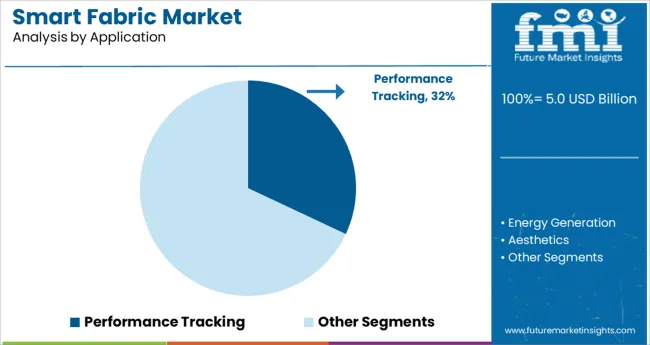
Performance tracking is projected to account for 32.0% of the total revenue share in the smart fabric market in 2025, making it the leading application segment. This growth is being driven by increasing consumer demand for wearables that monitor metrics such as heart rate, muscle activity, posture, and hydration in real-time.
Smart fabrics integrated with biometric sensors are being deployed in athletic wear, workwear, and lifestyle apparel to support personalized training and injury prevention. The segment’s expansion is also supported by growing awareness of fitness and wellness, particularly among younger demographics who seek tech-enabled solutions.
Additionally, integration with mobile apps and cloud-based analytics platforms has made performance-tracking garments more interactive and valuable to end users. As data security, battery efficiency, and washability continue to improve, this segment is expected to retain its leadership in driving mainstream adoption of smart fabrics.
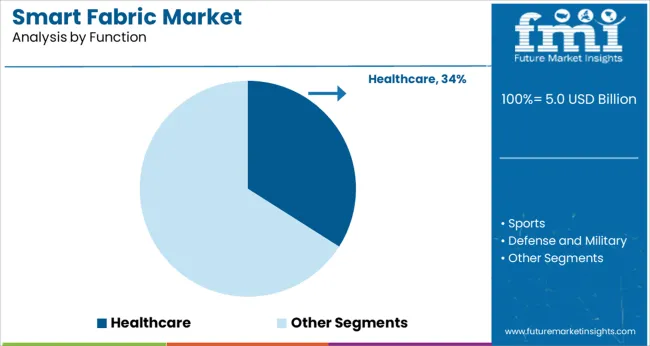
By function, healthcare is expected to contribute 34.0% of total market revenue in 2025, making it the leading functional area for smart fabric deployment. The increasing need for remote patient monitoring, chronic disease management, and aging population care has accelerated the adoption of smart textiles that can continuously measure vitals such as respiration, ECG, temperature, and pressure.
These fabrics enable non-invasive, long-term data collection without compromising patient comfort. Their usage is also being supported by healthcare institutions and insurance providers, who are looking for cost-effective tools to enhance preventive care and reduce hospital readmission rates.
Additionally, the integration of smart fabrics into rehabilitation and post-operative garments is providing enhanced outcomes through feedback-based therapy. As global health systems digitize and seek wearable solutions for clinical and at-home settings, healthcare applications are set to remain a priority driver for smart textile innovations.
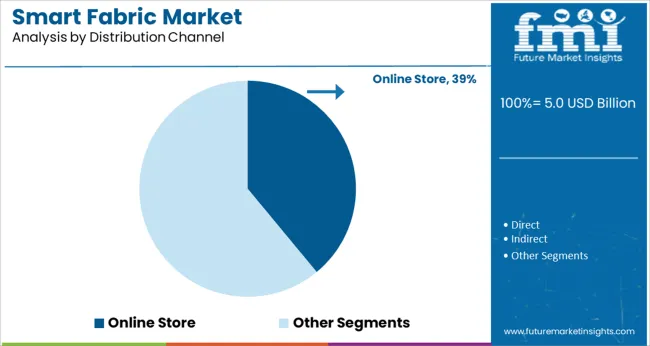
Online stores are projected to hold 39.0% of the total revenue share in the smart fabric market by 2025, ranking as the dominant distribution channel. This growth is being attributed to the increasing preference for digital-first purchasing, particularly among tech-savvy consumers who seek customization, access to product reviews, and transparent comparisons.
E-commerce platforms enable direct-to-consumer models that provide better pricing, faster feedback loops, and global reach—key advantages for emerging brands in the smart textile space. The COVID-19 pandemic further accelerated the shift toward online shopping for wearable tech, and consumers have maintained these habits due to convenience and accessibility.
Additionally, online platforms support rapid product iteration, crowdfunding for innovation, and targeted marketing strategies. With advancements in virtual fitting rooms, AR/VR integration, and personalized recommendations, the online store segment is expected to remain the primary driver of smart fabric sales and consumer engagement..
The fabric business is embracing smart fabrics, a brand-new invention that provides clients with numerous simple accessibilities in terms of performance and aesthetics of customers. Due to the hectic lifestyles that the majority of consumers are adopting and the increase in the number of workers, consumers increasingly demand everything they need in their day-to-day lives to be easily accessible.
Smart fabrics are simply the integration of monitors and sensors in clothing. This trend was introduced as a result of the increasing popularity of wearables and smart devices. There is a number of uses for these smart fabrics, especially in the healthcare sector. Smart sensors and monitors are used to detect and record the body temperature, heart rate, and other changes in the body. Such smart clothing will provide all the crucial information about the patient and help in treatment.
The smart fabric is also used in the defense sector for military uniforms. There are many smart features as temperature control and camouflage, which are really unique and revolutionary. The research and development in the sector are working on developing smart clothing with wireless communication technology for ease of accessibility. All these trending innovations are promising growth of the smart fabric market.
Smart fabrics are ensuring a promising future for the textile industry, but there are some restraints that this sector has to overcome.
The main problem with smart clothing is comfort. There are lots of wires inside this clothing attached to monitors. This is not comfortable for the user if the individual is working or resting. These wires and monitors can irritate the wearer and can cause rashes on the skin. This is one big concern to solve in front of smart textile companies.
There are chances of glitches and malfunctions of these monitors and sensors. The sensors attached to the smart clothing can malfunction, as there might be sweat, or some other factors disturbing the proper functioning. This problem defeats the whole purpose of smart clothing.
The monitors and sensors used for these smart clothes are expensive, and people on a tight budget cannot afford them. These clothes can be used only by premium-class people with high disposable income. Middle-class people might miss the advantages of this smart clothing.
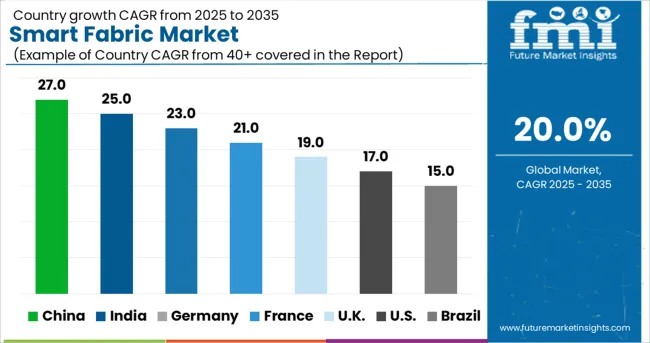
A team of Researchers at the Massachusetts Institute of Technology (MIT) has created smart fabrics that closely fit the body and employ a cutting-edge fabrication technique to detect the wearer's posture and movements. The incorporation of a unique kind of plastic yarn and a technique known as thermoforming, which involves gently melting the plastic yarn with heat, allowed the researchers to significantly increase the accuracy of pressure sensors, which are woven into multi-layered clothes, with the ‘3DKnITS tag’, monitoring the sensory data.
A team of researchers from the University of Fukui, Japan, and Nanjing University, China has developed a smart fabric that can charge small devices. This fabric is developed by using triboelectric nanogenerators. These generators use the energy produced by motion into electric energy. The electricity produced by these generators can be used to charge devices while doing physical activities like walking or running. This fabric is multi-layered, making it breathable and comfortable for the wearer.
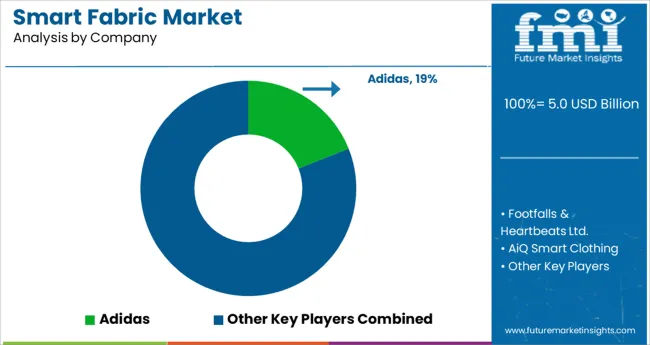
Some key players in the Smart Fabrics market are Adidas, Footfalls & Heartbeats Ltd., AiQ Smart Clothing, BoditTrak, DuPont, Lifesense, Nextiles, OTEX Specialty Narrow Fabrics, Bally Ribbon Mills, and others. These are popular and well-known brands all over the world.
| Attribute | Details |
|---|---|
| Growth Rate | CAGR of ~20% from 2025 to 2035 |
| The base year for estimation | 2024 |
| Historical Data Available for | 2020 to 2024 |
| Forecast Period | 2025 to 2035 |
| Quantitative units | Revenue in USD Billion, volume in Units, and CAGR from 2025 to 2035 |
| Report Coverage | Revenue forecast, volume forecast, company ranking, competitive landscape, growth factors, and trends, pricing analysis |
| Segments Covered | Application, Function, Distribution Channel, Region |
| Country scope | USA, Canada, Mexico, Germany, UK, France, Italy, Spain, Russia, India, Thailand, China, India, Japan, Australia, Brazil, Argentina, Colombia, Saudi Arabia, UAE, South Africa |
| Key Companies Profiled | Adidas; Footfalls & Heartbeats Ltd.; AiQ Smart Clothing; BoditTrak; DuPont; Nextiles; LifeSence; OTEX Specialty Narrow Fabrics; Bally Ribbon Mills; Others |
| Customization scope | Free report customization (equivalent to up to 8 analysts' working days) with purchase. Addition or alteration to country, regional & segment scope. |
| Pricing and purchase options | Avail customized purchase options to meet your exact research needs. |
The global smart fabric market is estimated to be valued at USD 5.0 billion in 2025.
It is projected to reach USD 31.0 billion by 2035.
The market is expected to grow at a 20.0% CAGR between 2025 and 2035.
The key product types are performance tracking, energy generation, aesthetics and others.
healthcare segment is expected to dominate with a 34.0% industry share in 2025.






Our Research Products

The "Full Research Suite" delivers actionable market intel, deep dives on markets or technologies, so clients act faster, cut risk, and unlock growth.

The Leaderboard benchmarks and ranks top vendors, classifying them as Established Leaders, Leading Challengers, or Disruptors & Challengers.

Locates where complements amplify value and substitutes erode it, forecasting net impact by horizon

We deliver granular, decision-grade intel: market sizing, 5-year forecasts, pricing, adoption, usage, revenue, and operational KPIs—plus competitor tracking, regulation, and value chains—across 60 countries broadly.

Spot the shifts before they hit your P&L. We track inflection points, adoption curves, pricing moves, and ecosystem plays to show where demand is heading, why it is changing, and what to do next across high-growth markets and disruptive tech

Real-time reads of user behavior. We track shifting priorities, perceptions of today’s and next-gen services, and provider experience, then pace how fast tech moves from trial to adoption, blending buyer, consumer, and channel inputs with social signals (#WhySwitch, #UX).

Partner with our analyst team to build a custom report designed around your business priorities. From analysing market trends to assessing competitors or crafting bespoke datasets, we tailor insights to your needs.
Supplier Intelligence
Discovery & Profiling
Capacity & Footprint
Performance & Risk
Compliance & Governance
Commercial Readiness
Who Supplies Whom
Scorecards & Shortlists
Playbooks & Docs
Category Intelligence
Definition & Scope
Demand & Use Cases
Cost Drivers
Market Structure
Supply Chain Map
Trade & Policy
Operating Norms
Deliverables
Buyer Intelligence
Account Basics
Spend & Scope
Procurement Model
Vendor Requirements
Terms & Policies
Entry Strategy
Pain Points & Triggers
Outputs
Pricing Analysis
Benchmarks
Trends
Should-Cost
Indexation
Landed Cost
Commercial Terms
Deliverables
Brand Analysis
Positioning & Value Prop
Share & Presence
Customer Evidence
Go-to-Market
Digital & Reputation
Compliance & Trust
KPIs & Gaps
Outputs
Full Research Suite comprises of:
Market outlook & trends analysis
Interviews & case studies
Strategic recommendations
Vendor profiles & capabilities analysis
5-year forecasts
8 regions and 60+ country-level data splits
Market segment data splits
12 months of continuous data updates
DELIVERED AS:
PDF EXCEL ONLINE
Smart School Bus Platform Market Size and Share Forecast Outlook 2025 to 2035
Smart Home Wireless Smoke Detector Market Size and Share Forecast Outlook 2025 to 2035
Smart Bus Platform Market Size and Share Forecast Outlook 2025 to 2035
Smart Vision Processing Chips Market Size and Share Forecast Outlook 2025 to 2035
Smart Touch Screen Scale Market Size and Share Forecast Outlook 2025 to 2035
Smart Magnetic Drive Conveyor System Market Size and Share Forecast Outlook 2025 to 2035
Smart Wheelchair market Size and Share Forecast Outlook 2025 to 2035
Smart Mining Technologies Market Size and Share Forecast Outlook 2025 to 2035
Smart Parking Market Size and Share Forecast Outlook 2025 to 2035
Smart Digital Valve Positioner Market Forecast and Outlook 2025 to 2035
Smart Card IC Market Size and Share Forecast Outlook 2025 to 2035
Smart-Tag Inlay Inserters Market Analysis - Size and Share Forecast Outlook 2025 to 2035
Smart TV Market Forecast and Outlook 2025 to 2035
Smart/AI Toy Market Size and Share Forecast Outlook 2025 to 2035
Smart Locks Market Size and Share Forecast Outlook 2025 to 2035
Smart Sprinkler Controller Market Size and Share Forecast Outlook 2025 to 2035
Smart Indoor Gardening System Market Size and Share Forecast Outlook 2025 to 2035
Smart Building Delivery Robot Market Size and Share Forecast Outlook 2025 to 2035
Smart Watch Market Size and Share Forecast Outlook 2025 to 2035
Smart Label Market Size and Share Forecast Outlook 2025 to 2035

Thank you!
You will receive an email from our Business Development Manager. Please be sure to check your SPAM/JUNK folder too.
Chat With
MaRIA